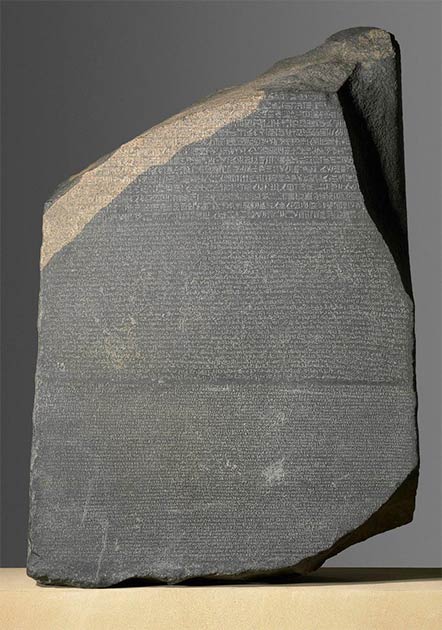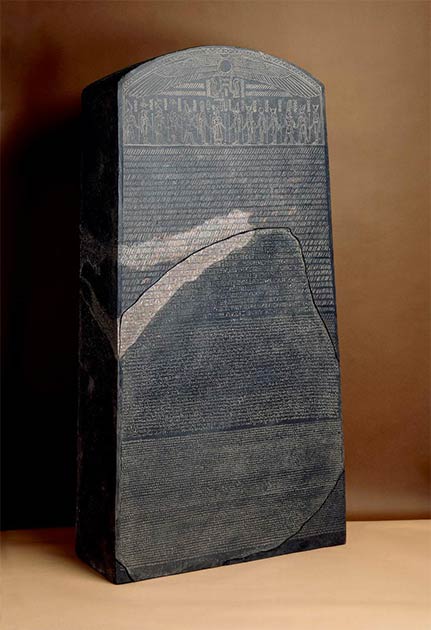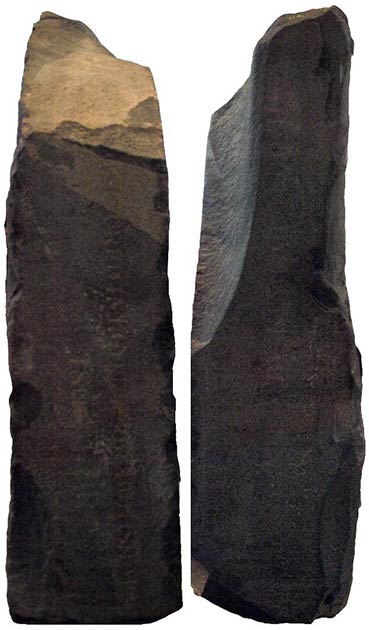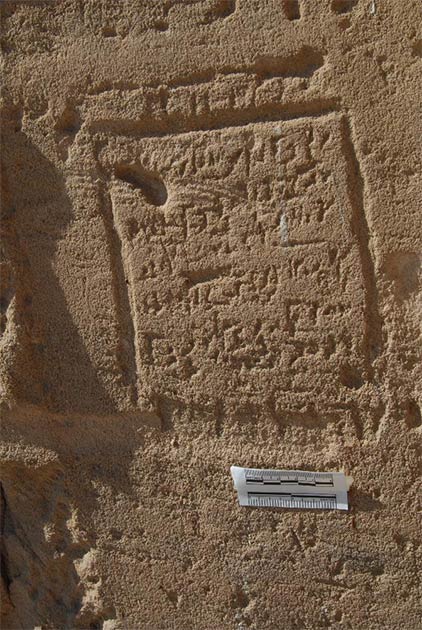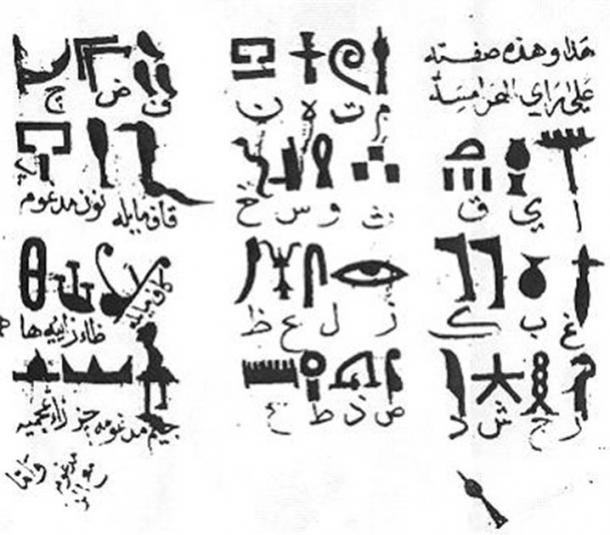List members , the Rosetta Stone is a priceless artefact . It is till date THE most valuable archaeological discovery , without which the ancient Egyptian hieroglyphic script could never have been deciphered .
**One hopes , something similar will one day be found to decipher the enigmatic Indus Valley script .
On a separate thread , Soretna has already given us the good news of the mysterious Voynich manuscript getting deciphered :))
The Rosetta Stone: One of Archaeology’s Greatest Treasures
The Rosetta Stone is one of the most significant discoveries in the history of archaeology. This artifact was created during the Ptolemaic Period, and was rediscovered at the end of the 18th century. Thanks to the discovery of the Rosetta Stone, ancient Egyptian hieroglyphs could be deciphered, unveiling secrets of the ancient civilization.
The man credited with this achievement is the French scholar Jean-François Champollion, though the story involves several other scholars as well. These men, however, are often forgotten, being overshadowed by Champollion.
Looking from another angle, the tale of the Rosetta Stone is also one of the French-British rivalry during the Napoleonic era. As a result of this rivalry, even though the artifact was discovered by the French, it ended up in the British Museum.
What is the Rosetta Stone?
The Rosetta stone is a block of black-colored granodiorite with an irregular shape. The stone is thought to be a fragment of a larger stele which had been broken in antiquity. The other fragments of the stele, however, have yet to be found. The Rosetta Stone measures about one meter (about 3 ft.) in height, and about 0.75 meters (about 2.5 ft.) in width.
The stone contains three different scripts – ancient Egyptian hieroglyphs (top), Demotic (middle), and Greek (bottom). All three texts tell the same story; therefore, understanding one script would enable a scholar to decipher the others. It was thanks to this trilingual script that Champollion succeeded in deciphering the ancient Egyptian hieroglyphs.
- Warrior’s Beat Up Body Confirms Rosetta Stone’s Message
- The father of Egyptology suffered a tragic death after deciphering the Rosetta Stone
The Rosetta Stone. (Trustees of the British Museum/ CC BY NC SA 4.0 )
Who Discovered the Rosetta Stone?
The story of the Rosetta Stone’s rediscovery begins in 1798, when Napoleon Bonaparte invaded Egypt . The French intended to seize Egypt, which was then a province of the Ottoman Empire (though it was in fact controlled by the Mamluks). Napoleon also hoped to use Egypt as a base to disrupt Britain’s access into India.
The French easily seized Alexandria and Cairo from the Mamluks. In the following year, the French launched an expedition into Palestine and Syria, which came to an end when they failed to take Acre. It was in that year that the Rosetta Stone was unearthed.
In the middle of July 1799, the French were repairing a dilapidated fort (which they renamed Fort Julien) near the port city of Rashid, on Egypt’s north coast. The French referred to the city as Rosetta. During the renovations on the fort, a military engineer by the name of Pierre-François Bouchard noticed that a stone found in the fort was covered with writing.
Possible reconstruction of the full Rosetta stele. (Trustees of the British Museum/ CC BY NC SA 4.0 )
Bouchard was convinced of the artifact’s importance, so it was sent to the Institut d'Égypte (Egyptian Scientific Institute) in Cairo. Napoleon is said to have inspected the Rosetta Stone himself before his return to France in August that year.
Why the Rosetta Stone Ended Up in the British Museum
The Rosetta Stone was regarded by the French as a trophy of war, but it never made it back to Paris. The French did not occupy Egypt for long, as they surrendered to the British and Ottoman forces in 1801. One of the objects seized from the French by the victorious British was the Rosetta Stone.
The artifact was transported back to England. Interestingly, the British left their mark on, or vandalized, (depending on one’s point of view) the Rosetta Stone. Two inscriptions in white can be seen on the broken edges of the stone, one on the left, and another on the right. The former reads ‘CAPTURED IN EGYPT BY THE BRITISH ARMY IN 1801’, and the latter proclaims, ‘PRESENTED BY KING GEORGE III’.
The left and right sides of the Rosetta Stone, containing the faint English inscriptions saying: (L) "Captured in Egypt by the British Army in 1801" (R) "Presented by King George III." (Captmondo/ CC BY SA 3.0 )
Subsequently, the Rosetta Stone arrived in the British Museum in London. The artifact has been exhibited there since then, except during the period of the First World War, when it was temporarily relocated to an off-site, underground spot for safekeeping. After some time, white chalk was used to color the inscriptions, in order to make them more legible.
The Difficulty in Deciphering Hieroglyphs
Apart from that, copies and transcriptions of the ancient scripts were made, so that they may be studied by scholars around the world. At that time, the hieroglyphic and Demotic scripts of the Rosetta Stone were still undeciphered. Thus, the Greek inscription was a starting point for scholars.
- 5 Important Egyptian Archaeological Discoveries that Provided Leaps in Our Knowledge of the Past
- The Philae Obelisk, Hieroglyphs and Understanding a Vanished Culture
Although ancient Greek was already widely known among Western scholars of that time, translating the text was still a challenge since the Greek of the Rosetta Stone was of a variety that scholars were not familiar with yet. In any case, several scholars managed to translate the Greek portion of the Rosetta Stone, which paved the way for the decipherment of the other two scripts.
Although Champollion is credited with the decipherment of ancient Egyptian hieroglyphs, efforts to decipher the script were undertaken long before the 19th century. Okasha El Daly, an Egyptologist at UCL’s Institute of Archaeology, makes a case for the interest shown by the Medieval Arabs in hieroglyphs, as well as their efforts in deciphering the script. By that time, both hieroglyphs and Demotic had fallen out of use. In fact, these two scripts were last used during the 5th century AD. The last known inscriptions in these scripts are from Philae, an island near Egypt’s southern border.
Demotic graffiti at the Temple of Philae. (Eugene D. Cruz-Uribe/ CC BY NC )
An example given by El Daly to support his case is the fact that some mosques were built on top of abandoned ancient Egyptian temples, and that worshippers would have been curious about the symbols they saw on the ancient ruins. The interest in hieroglyphs is also evident their use as decorative motifs. Moreover, as El Daly points out, Egypt was renowned since ancient times as a land of science. Therefore, the Muslims who conquered Egypt during the 7th century AD believed that by deciphering the hieroglyphic script, they would be able to access a vast repository of ancient scientific knowledge.
This was especially attractive for alchemists, who were in search of ancient and lost knowledge. In Abu al-Qasim al-Iraqi’s Kitab al-Aqalim , for instance, alchemical symbols inspired by hieroglyphs can be seen. Some alchemists even attempted to decipher the hieroglyphs. One of these, for instance, is Jabir ibn Hayan, who lived during the 8th century AD.
According to later scholars, he had written an encyclopedic work on the decipherment of various ancient scripts, including hieroglyphs. Unfortunately, this work has not survived. Another Muslim alchemist who tried to decipher hieroglyphs is the 10th century Ibn Wahishiya, who was originally from Iraq. Since his book on the decipherment of hieroglyphs has survived, Ibn Wahishiya is considered to be the first scholar to have partially deciphered the hieroglyphs.
Ibn Wahishiya’s translation of the Ancient Egyptian hieroglyph alphabet in 985. ( Public Domain )
According to El Daly, Ibn Wahishiya’s work shows that the alchemist understood that the hieroglyphic symbols have phonetic value, rather than functioning merely as pictures or symbols. This realization, however, was already made by Muslim scholars before Ibn Wahishiya. Nevertheless, Ibn Wahishiya contributed to the existing knowledge by pointing out that some of the symbols served another function, i.e. as determinatives. These symbols were placed at the end of words, and were used to define their exact meaning.
Even in Europe, attempts to decipher ancient Egyptian hieroglyphs predated the Rosetta Stone. The British Egyptologist E. A. Wallis Budge traces the beginning of the study of hieroglyphs in ‘modern’ times to 1556, when Giovanni Pierio Valeriano Bolzani published his Hieroglyphica , a treatise on the sacred writings of ancient Egypt and other nations. In the centuries that followed, various European scholars attempted to decipher the ancient script, though none succeeded.
The failure of these scholars, who were men of great learning, was due primarily to the fact that they could not grasp the character of the script and the way the symbols were used. Therefore, it was crucial for scholars to first understand the nature of the hieroglyphic script before they could begin to decipher it.
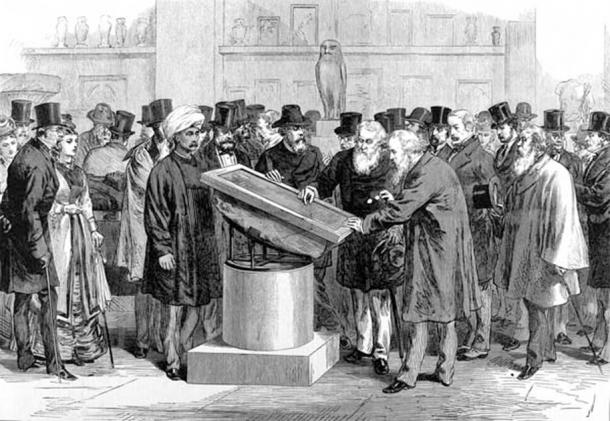
Experts inspecting the Rosetta Stone during the International Congress of Orientalists of 1874. ( Public Domain )
From Greek to Demotic to Egyptian Hieroglyphs
Returning to the Rosetta Stone, once the Greek portion was translated, scholars were able to work on the hieroglyphs and Demotic . One of the first scholars to investigate the scripts on the artifact was the French Orientalist Silvestre de Sacy. He sought to decipher the Demotic using the Greek during the early years of the 19th century. de Sacy attempted to figure out the phonetic value of the signs. Apart from identifying some Greek proper names, however, he was unable to make much real progress. Seeing that his work was taking him nowhere, de Sacy eventually gave up on the Rosetta Stone.
The first scholar to make any real progress in the study of the Rosetta Stone was the British polymath Thomas Young. In 1814, Young began his study of the Rosetta Stone. Although he focused on the Demotic, like de Sacy before him, he was also investigating the hieroglyphs.
Four years later, he published articles on his findings in the Encyclopaedia Britannica . At the time when Young was doing his research, there was already a long-held assumption that the hieroglyphic symbols enclosed in cartouches (an oval with a horizontal line on one end) were in fact the phonetic spellings of royal names. Young applied his hypothesis to the cartouches of the Rosetta Stone, and realized that it worked. In addition, by looking at the direction the animals and birds were facing, Young figured out the direction in which the text ought to be read.
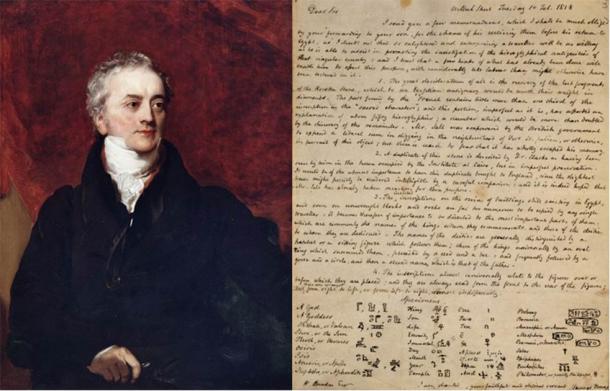
Thomas Young ( Public Domain ) and a letter he wrote in 1818 about hieroglyphs. (Trustees of the British Museum/ CC BY NC SA 4.0 )
Despite these significant breakthroughs, the hieroglyphs on the Rosetta Stone were still undeciphered. Part of the problem was the suspicion held by Young regarding the phonetic value of the symbols. Although he knew that the symbols for foreign names had phonetic value, he was reluctant to apply it to the entire script.
This view, however, was challenged by Jean-François Champollion , who studied the Rosetta Stone during the 1820s. Between 1822 and 1824, Champollion demonstrated that some of the hieroglyphic symbols contained phonetic value, others an ideographic one, and yet others served as determinatives. Champollion also showed that the hieroglyphic script was a translation of the Greek one, rather than the opposite, as it was widely believed at the time.
Although the decipherment of the hieroglyphs was now achieved, it was still not quite complete, as more texts had to be studied before Champollion’s work could be proven to be correct. This occurred in the decades that followed, which earned Champollion the title ‘Father of Egyptology’.
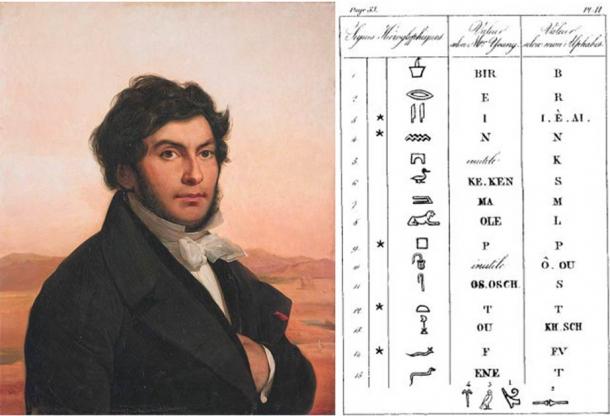
Jean-François Champollion ( Public Domain ) and his comparison of his own decipherment of the letters in the name Ptolemy, with that of Young (middle column). ( Public Domain )
What Do the Rosetta Stone Inscriptions Say?
With regards to the text on the Rosetta Stone, it is basically a decree confirming the cult of Ptolemy V. Based on the text, Egyptologists were able to determine that the decree was issued in 196 BC, on the first anniversary of the pharaoh’s coronation. Ptolemy inherited the throne of Egypt in 205 BC, when he was six years old.
He was, however, only crowned much later, as there were revolts throughout the kingdom. In any case, the decree was issued by the Egyptian priests (supposedly the ones from Memphis) to mark the coronation of the pharaoh, and to confer onto Ptolemy the status of a living god. In return for their support, the priests received a number of benefits, including tax breaks for them and their temples, and being freed from the obligation to meet annually in Alexandria. They were allowed to meet in Memphis instead.
- Rosetta-style engraving lauding Cleopatra I and two Ptolemaic Pharaohs unearthed in Egypt
- Fuente Magna, the Controversial Rosetta Stone of the Americas
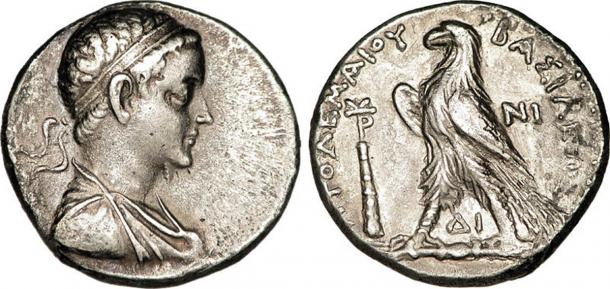
Tetradrachm issued by Ptolemy V Epiphanes. ( CC BY SA 3.0 )
The Story of the Stone Continues…
The story of the Rosetta Stone may have begun during the 2nd century BC, but is ongoing. This story contains many chapters, from its original purpose as a decree confirming the legitimacy of Ptolemy’s rule (and the benefits the pharaoh had to bestow on the priests), to its rediscovery, which highlights the rivalry between Britain and France during the Napoleonic era, and the role it played in the decipherment of ancient Egyptian hieroglyphs. Today, however, the Rosetta Stone is going through another chapter of its history.
Although the Rosetta Stone is housed today in the British Museum, there have been calls by the Egyptian government for its repatriation. While the Rosetta Stone would be considered a looted / stolen artifact, according to modern military conventions and agreements prohibiting wartime pillaging and looting , these laws did not exist during the early 19th century.
Nevertheless, the Egyptian government is adamant that the Rosetta Stone (along with many other artifacts that were taken out of the country) should be returned to them. The British Museum, on the other hand, is equally determined to hold on to this priceless artifact. This is still an issue and only time will reveal the ending of this chapter of the Rosetta Stone’s story .
Regards
